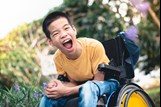- Reading and writing, for example because they have dyslexia
- Ability to understand things
- Behaviour or ability to socialise, for example they struggle to make friends
- Concentration levels, for example because they have ADHD
- Physical ability to do things such as writing.
There are two questions to ask when thinking about whether a child or young person has SEN.
1. Does the child/young person have a learning difficulty or disability?
A child or young person has a learning difficulty or disability if:
- They have significantly greater difficulty in learning than the majority of others of the same age,
or - They have a disability which makes it difficult for them to use the facilities normally provided for others of the same age in mainstream schools or post-16 institutions
Someone has a disability if they have a physical or mental impairment which has a substantial and long-term adverse effect on their ability to carry out day-to-day activities.
2. Does that learning difficulty or disability call for special educational provision to be made?
Special educational provision is any educational or training provision that is additional to, or different from, that made generally for other children or young people of the same age. This is a wide definition, and could cover a wide range of things, for example:
- Having materials provided in a larger font
- Needing one-to-one support
- Communicating through sign language
- Needing small class sizes
Some children or young people may need additional support which is not special educational provision; for example they might need certain treatments or medicines administered at school because of a medical condition they have. In order to be classed as having SEN, they must require support with education or training which is different from that given to other children or young people of the same age.
If the answer to both of these questions is yes, then the child or young person has SEN.
It is important to note that the SEND Code of Practice 2015 defines 4 broad areas of need;
- Communication and Interaction
- Sensory and/or Physical
- Cognition and Learning
- Social, Emotional and Mental Health Needs
When supporting children and young people, it is important to consider all 4 areas of need. Children and young people with medical conditions and those with mental health difficulties, should be supported by the school SENco.









